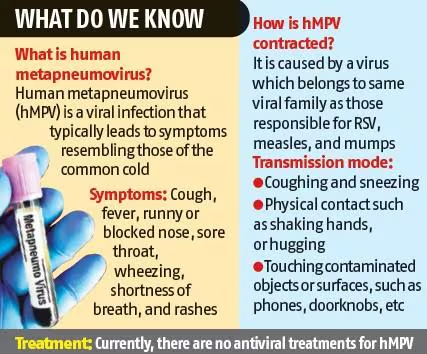Introduction
Human metapneumovirus (HMPV) is a significant respiratory pathogen that primarily affects individuals of all ages, particularly young children, the elderly, and those with compromised immune systems. Discovered in 2001 by Dutch researchers, HMPV has gained recognition as a common cause of respiratory infections, often mimicking other viral infections like influenza and respiratory syncytial virus (RSV). It belongs to the Pneumoviridae family and is characterized by its lipid envelope and single-stranded RNA genome.
Epidemiology and Transmission
HMPV is predominantly transmitted through respiratory droplets when an infected person coughs or sneezes. The virus can also survive on surfaces for a limited time, making it possible to contract the infection through contact with contaminated surfaces. The incubation period for HMPV is typically between 3 to 6 days, during which individuals may be contagious even before showing symptoms.
Risk Groups
-
- Children: Most children are infected by the age of five, with severe cases more common in those under two years old.
- Elderly: Older adults are at higher risk for severe disease due to age-related immune decline.
- Immunocompromised Individuals: Patients with weakened immune systems or underlying respiratory conditions are particularly vulnerable to severe outcomes.
Clinical Manifestations
HMPV infection can present as either an upper or lower respiratory tract infection:
Upper Respiratory Tract Infection
Common symptoms include:
-
- Cough
- Nasal congestion
- Sore throat
- Rhinorrhea (runny nose)
Lower Respiratory Tract Infection
Symptoms may escalate to include:
-
- Wheezing
- Fever
- Shortness of breath
- Hypoxia (low oxygen levels)
In children, HMPV can lead to serious conditions such as bronchiolitis, pneumonia, and exacerbations of asthma. In adults, it can exacerbate chronic obstructive pulmonary disease (COPD) and lead to pneumonia.
Diagnosis
Diagnosis of HMPV typically involves clinical evaluation and laboratory testing. While there are no specific antiviral treatments for HMPV, healthcare providers may use molecular diagnostic tests such as PCR (polymerase chain reaction) to confirm the presence of the virus. Differential diagnosis is important as symptoms often overlap with those of other respiratory viruses.
Treatment and Management
Currently, there is no specific antiviral treatment for HMPV. Management focuses on supportive care, which may include:
-
- Hydration
- Antipyretics (to reduce fever)
- Supplemental oxygen in cases of hypoxia
- Hospitalization for severe cases requiring intensive care
Most infections are self-limiting, and patients generally recover with appropriate symptomatic treatment.
Prevention
Preventive measures are essential to reduce the transmission of HMPV:
-
- Hand Hygiene: Regular handwashing with soap and water or using alcohol-based hand sanitizers.
- Respiratory Hygiene: Covering coughs and sneezes with tissues or elbows.
- Surface Cleaning: Disinfecting frequently-touched surfaces.
- Staying Home When Sick: Individuals showing symptoms should avoid close contact with others.
Conclusion
Human metapneumovirus is an important respiratory pathogen that poses a significant health risk, particularly among vulnerable populations. As awareness of HMPV increases, particularly in light of its similarities to other respiratory viruses, ongoing research into its epidemiology, pathogenesis, and potential treatments will be crucial. Understanding HMPV’s impact on public health can help inform prevention strategies and improve patient outcomes in respiratory infections.
Spread the Word

